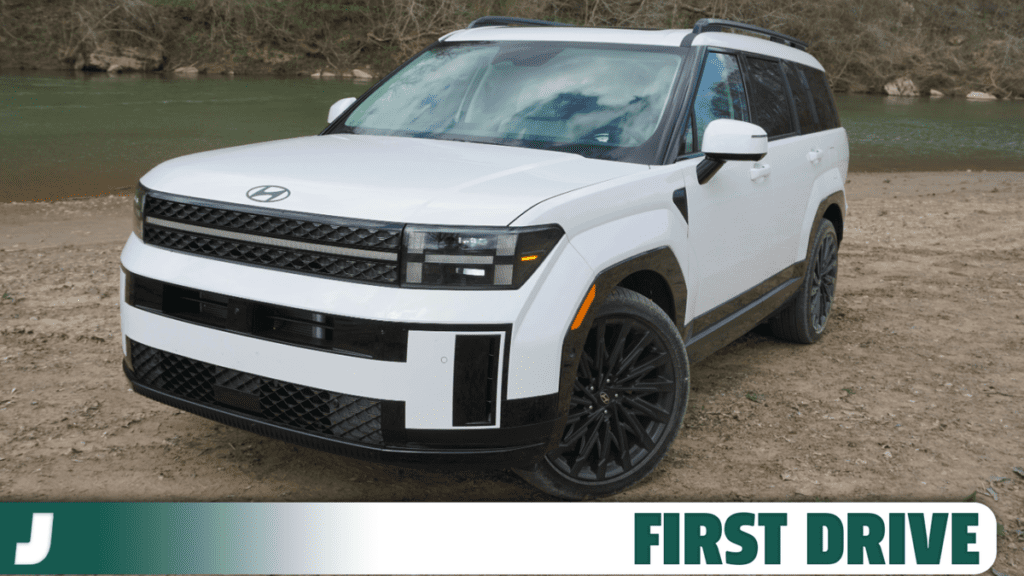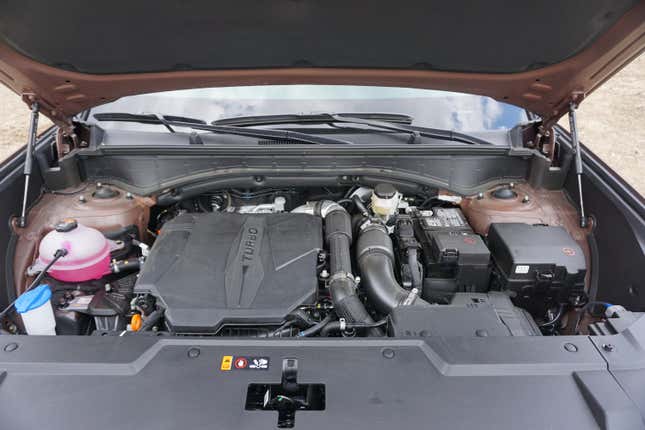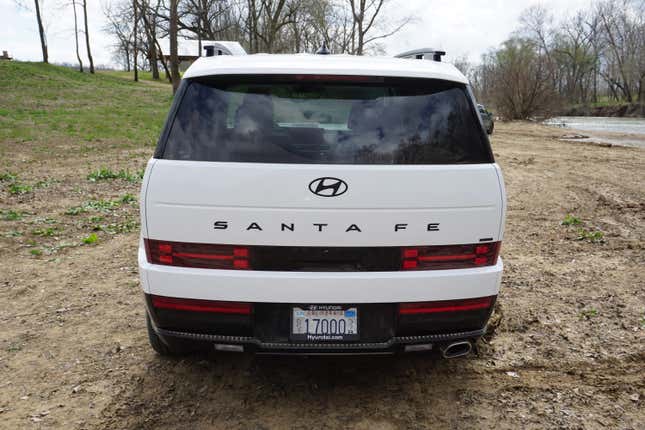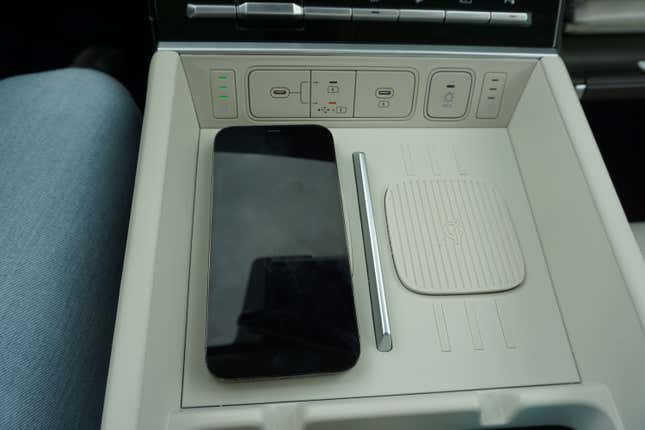The 2024 Hyundai Santa Fe Is The Crossover To End All Crossovers

A little less than a year ago, I had the opportunity to get up close and personal with the fifth-generation 2024 Hyundai Santa Fe in its namesake city in New Mexico. Unfortunately, I wasn’t able to drive it at the time, but now that has changed — I just got back from driving Hyundai’s latest “compact” crossover in Tennessee, experiencing how it conducts itself both on and off the road as well as how all of its features work in the real world. And I’ve gotta say, damn this thing is good. No matter what situation you find yourself in with the new Santa Fe, it is more than up to the task, especially if that task is delivering Land Rover Defender styling for about half the price.
Few vehicles really deliver on what their looks and spec sheets promise, but the 2024 Hyundai Santa Fe is absolutely one of those cars.
Full Disclosure: Hyundai flew me out to Franklin, Tennessee, put me up in a very nice hotel and fed me delicious food all so I could try out their newest vehicle that was already on sale.
Photo: Andy Kalmowitz / Jalopnik
If I were a different kind of guy — someone who didn’t know his audience — I’d probably bury how the Santa Fe drives at the end of this story. After all, who the hell cares how a crossover with a turbocharged 2.5-liter inline-four engine and six comfy seats actually drives? Well, nerds, I know we all do.

Photo: Andy Kalmowitz / Jalopnik
Starting with the boilerplate facts, the new Santa Fe’s standard engine is the aforementioned turbo four, which is good for 277 horsepower and 311 pound-feet of torque. All that torque is routed through an extremely responsive 8-speed dual-clutch automatic transmission. If you’re looking to go electric (sort of), you can also opt for a turbocharged 1.6-liter inline-four hybrid paired up with a 6-speed automatic transmission. Both powerplants can be had with either front- or all-wheel drive (an $1,800 option) on every trim level in the lineup other than the off-road-focused XRT trim.
I drove two Santa Fes during my testing, a top-of-the-line Calligraphy ($50,375 as tested) on-road and a middle-of-the-range XRT ($43,205 as tested) off-road. Both vehicles were fitted with the 2.5-liter engine, and it proved to be a super strong power unit no matter the terrain. I wouldn’t exactly call it fast, because it isn’t, but it’ll get the job done for anyone who is buying this type of vehicle.

Photo: Andy Kalmowitz / Jalopnik
On pavement, the Santa Fe is extremely quiet and relaxing. You hear the grumble of the 2.5-liter engine from time to time — it’s the nature of a four-popper, after all — but it’s not exactly intrusive. Wind and road noise is kept to a minimum, even when the surface is less-than-ideal. The eight-speed dual-clutch was surprisingly snappy for this type of application. It fired off up- and down-shifts as quickly as you could ever really want them to be, even when using the steering wheel–mounted paddle shifters.
The Santa Fe’s cornering isn’t anything to write home about, but what exactly did you expect? This is a 4,500-pound crossover after all. It isn’t offensive by any means, but a corner carver the Santa Fe is not. I suppose you feel something through the leather-wrapped steering wheel, but it isn’t the road. There’s a Sport mode you can select, but it’s mostly just there for vibes. I suppose the steering gets a little bit heavier and the throttle response is a bit snappier, but that’s about it. Again, what did you expect? Leave it in the “Normal” and you’ll be fine.

Photo: Andy Kalmowitz / Jalopnik
When it comes to leaving the pavement, the Santa Fe really surprises. Hyundai built the XRT trim to be able to hold its own off-road, and it did — I’m not going to sit here and tell you the XRT is better than something like a Jeep Wrangler, Ford Bronco or Defender off-road, but it’s solid, and I did a way more intense off-road course than any Hyundai Santa Fe owner would ever dare to do.
All of the Santa Fe’s off-roading is done without fancy modes. There are only two things you can change to make the Santa Fe more off-road ready: locking the all-wheel-drive system and enabling hill descent control. Everything else is accomplished through the Santa Fe’s pure willpower.

Photo: Andy Kalmowitz / Jalopnik
The XRT does get a number of actual modifications to better attack the trails. It’s fitted with 18-inch wheels and chunkier all-terrain tires, and its overall ride height is raised to 8.3 inches, a 1.3-inch bump over the standard Santa Fes. Hyundai also says the XRT can tow up to 4,500 pounds, while regular Santa Fes can only muster 3,500 pounds.
On the outside, the Santa Fe has gone through one of the biggest generational glow-ups I’ve ever seen. The previous-gen crossover wasn’t bad-looking, but the new car just looks exceptional. Gone are the curved lines and soft edges of the previous Santa Fe. In their places are boxy shapes, hard lines and right angles. Damn, does it look good, and the fact it’s so solid off-road is a relief — I’d hate if this thing didn’t deliver on what its looks promised.

Photo: Andy Kalmowitz / Jalopnik
Aside from the styling, the Santa Fe’s size is the biggest (I’m so sorry) change. It has grown in every dimension over the fourth-generation car, and it’s now only six inches shorter than its Palisade stablemate, but Hyundai is adamant the two SUVs do not compete with each other. Please disregard the fact they have similar prices, seat the same amount of people and are now basically the same size. Okay, to be fair to Hyundai, the next-generation Palisade is rumored to be getting both bigger and boxier to make room for the new Santa Fe. Still, Hyundai doesn’t even consider the Santa Fe to be a mid-size crossover. It still classifies the vehicle as a “compact crossover.” Sure, Jan.

Photo: Andy Kalmowitz / Jalopnik
At last year’s event, Hyundai’s Design Chief SangYup Lee told us the design process for the new Santa Fe started with its incredibly wide tailgate at the back, and everything else about the car was designed with that feature in mind. If you’re thinking the taillights are sort of low, well, you’re not wrong. They are, but that positioning serves a purpose. With the taillights mounted lower on the body, it allows for a thinner tailgate strut, which makes the housing for the tailgate thinner as well. All that allowed the designers and engineers to make that huge rear hatch opening. It’s also meant to harken back to SUVs of years gone by that had low taillights. Love it or hate it, it’s certainly distinctive.
The rest of the exterior design is super cohesive, and it doesn’t look like much else on the road (if you ignore Defenders). There are little “H” easter eggs everywhere, including the headlights, taillights, bumpers and grille, just to name a few. They’re a little corny, but it’s cute. There’s one little feature of the exterior that really caught my attention: the weird little rectangle on the C-pillar. As it turns out, it’s a handle, which Hyundai explains makes it easier for folks to climb up onto the roof to access their active lifestyle equipment strapped upon it.

Photo: Andy Kalmowitz / Jalopnik
The themes of the exterior continue once you step inside the Santa Fe namely the “H” motif and clean lines. Hyundai is offering five interior colors to choose from; the only interesting color options are Pecan Brown and Forest Green. It would be cool if those two could be mashed together, but alas. That’s right, you can spec an “Earthy Brass Matte” or “Terracotta Orange” Santa Fe with a green interior, which has quickly made this one of my favorite vehicles ever. Despite its utilitarian nature, all the materials inside the Santa Fe feel quite premium and everything seems well put together.

Photo: Andy Kalmowitz / Jalopnik
Anyone who has spent time inside Hyundai or Kia’s EVs will feel right at home in the Santa Fe. Similarities include Hyundai’s trick “Relaxation Seat” with a leg rest for front-row occupants. I just always assumed they were just for EV drivers waiting for their vehicles to charge. The “H” theme continues through the cabin with the dashboard air vents, but take notice that there isn’t any lettering or Hyundai logo on the steering wheel. Instead, there are just four dots that designers noted represent the letter “H” in Morse code. How cute.
Hyundai also moved the gear shifter from the center console to the steering column, which freed up a ton of space that the designers filled with a lot of other things. For example, there are now two wireless charging pads that’ll both get your phone decently hot, though it does charge them quickly. Underneath that area is a huge cubby hole to throw your junk in.

Photo: Andy Kalmowitz / Jalopnik
Above that center console is a 6.6-inch touchscreen climate control display that does include some physical buttons. I suppose it’s nice that you can control temperature through a dial, but I wish the whole thing would be real buttons rather than a screen, as it did require me to take my eyes off the road to operate.

Photo: Andy Kalmowitz / Jalopnik
The main focal point of the interior are the dual 12.3-inch curved displays that serve as the gauge cluster and center infotainment screen. Both displays are fairly customizable and easy to use, and they’re standard on the Limited and Calligraphy models. Lower trims like the SE, SEL and XRT keep the 12.3-inch center display but lose the digital gauge cluster in favor of a small 4.3-inch screen flanked by two gauges. On the tech side of things, Hyundai was very proud to share that its designers and engineers included a UV sanitizing tray in the interior, which was apparently a decision brought on by the pandemic. It’s definitely unique and not something I’ve come across in a car before, though I’m not sure exactly how useful it is. There’s also a digital rear-view mirror with a camera to better aid drivers, especially when there is too much junk in the trunk.
It will not come as too much of a surprise to learn that the Santa Fe comes with every driver assistance and safety feature currently on the market — lane-keeping assist, forward collision avoidance, and adaptive cruise control are all here and accounted for. Also, as is a growing trend in the industry, you can use your phone as a car key in the new Santa Fe. Hyundai will also provide over-the-air updates to make sure the car is up to snuff for buyers.

Photo: Andy Kalmowitz / Jalopnik
Roominess is the name of the game when it comes to the Santa Fe’s interior, and that makes a whole of sense — it is a family vehicle at the end of the day. Hyundai says the Santa Fe now has class-leading interior space because of its 110.8-inch wheelbase and 190.2-inch overall length. That roominess is evident the second you fold the rear seats flat. There’s nearly 80 cubic feet of interior cargo volume behind the front seats, and that number shrinks to a still-respectable 14.6 cubes of cargo room with all the seats up.
The Santa Fe also has class-leading second- and third-row legroom, according to the Korean manufacturer. Second-row citizens in the gas-powered crossover are treated to 42.3 inches of legroom. If you’re piloting a hybrid, though, second-row passengers will have to make do with a slightly smaller 41.5 inches. As for those stuck in the third row, don’t worry. You’ve got plenty of space with 29.9 inches of legroom, and you can even recline the third-row seats by 10 degrees. All that is to say my 6’1” self fits extremely comfortably in the second row, and the third row is bearable.

Photo: Andy Kalmowitz / Jalopnik
After spending a whole lot of time — and a couple hundred miles — with this new “compact” crossover, I can say without a doubt in my mind that Hyundai has a winner on its hands with the 2024 Santa Fe It doesn’t matter how you spec your Santa Fe or what trim you go with, the Santa Fe is as solid at its $35,455 (including $1,395 for shipping) base price as it is fully loaded at $50,695.
Whatever you plan to do with the new Santa Fe, whether it’s carrying all your friends and their stuff or blasting up what seems like an impossibly steep and muddy road, it delivers. This is a good vehicle through and through — just don’t call it a compact crossover.




